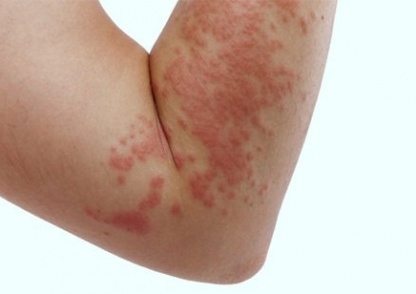Traditional uses and medicinal potential of Cordyceps sinensis of Sikkim
Abstract
Cordyceps sinensis has been described as a medicine in old Chinese medical books and Tibetan medicine. It is a rare combination of a caterpillar and a fungus and found at altitudes above 4500m in Sikkim.
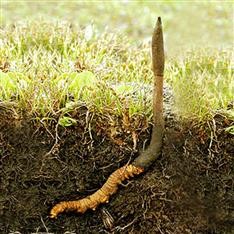
Traditional healers and local people of North Sikkim recommend the mushroom, i.e., Yarsa gumba, Keera jhar (C. sinensis) for all diseases either as a single drug or combined with other herbs. The present study was undertaken to collect information regarding the traditional uses of cordyceps in Sikkim. It was found that most local folk healers/traditional healers use cordyceps for the treatment of 21 ailments. A modern literature search was carried out to assess whether the curative effects are valid or just blind faith of local people. Chemical constituents of cordyceps are given and pharmacological and biological studies reviewed. More mechanism-based and disease-oriented clinical studies are recommended. Cordyceps sinensis has been described as a medicine in old Chinese medical books and Tibetan medicine. It is a rare combination of a caterpillar and a fungus and found at altitudes above 4500m in Sikkim. Traditional healers and local people of North Sikkim recommend the mushroom, i.e., Yarsa gumba, Keera jhar (C. sinensis) for all diseases either as a single drug or combined with other herbs. The present study was undertaken to collect information regarding the traditional uses of cordyceps in Sikkim. It was found that most local folk healers/traditional healers use cordyceps for the treatment of 21 ailments. A modern literature search was carried out to assess whether the curative effects are valid or just blind faith of local people. Chemical constituents of cordyceps are given and pharmacological and biological studies reviewed. More mechanism-based and disease-oriented clinical studies are recommended.
INTRODUCTION
Mushrooms have been used as food, medicine, poison, and in spiritual mushroom practices in religious rituals across the world since at least 5000 BC.[1] Gordon Wasson (father of modern Ethno mycology) believed that the Soma plant used in religious ceremonies, over 4000 years ago, before the beginning of the Christian era, by the people who called themselves “Aryans” was a mushroom. The Vedic juice called “soma rasa” is said to bestow divine qualities on the soul of the consumer, even immortality.[2] Ayurveda classifies mushrooms under tamasika ahara, and as a medicine for enhancing vigor and vitality.[3] The fungus Cordyceps sinensis has been described in old Chinese medical books from ancient times, and is also found in Tibetan medicine.[4] The fungus Penicillium from which the antibiotic penicillin is derived is the most famous medicine of the age, and the most potent hallucinogen agent Lysergic acid diethylamide(LCD), has also been derived from the plant – parasite ergot fungus Claviceps purpurea.[5,6]
Traditional healers in Sikkim recommend the fungus/mushroom Cordyceps sinensis for “all illnesses” as a tonic, because they claim that it improves energy, appetite, stamina, libido, endurance, and sleeping patterns. It is a rare combination of a caterpillar and fungus found in Sikkim at altitudes above 3,800 m. The mushroom is most popular in the Lachung and Lachen area of North Sikkim and has the reputation of being a precious longevity-promoting herb. The present study was undertaken to collect as much information as possible regarding traditional claims for its uses in different diseases. Attempts to evaluate such claims through studies of available modern literature were also made.
INFORMATION GATHERING
North Sikkim is a vast reservoir of high-altitude medicinal and aromatic plants. Its people possess a treasury of knowledge related to their management and uses. There are a number of reputed classes of practitioner like the Amchi (Tibetan folk practitioner) and Vaidyas (herbalist/folk healers). Relevant information was gathered from local people, local practitioners, folk healers, and by direct contact with herb collectors of Lachung and Lachen, during repeated field visits between June 2008 and September 2009.
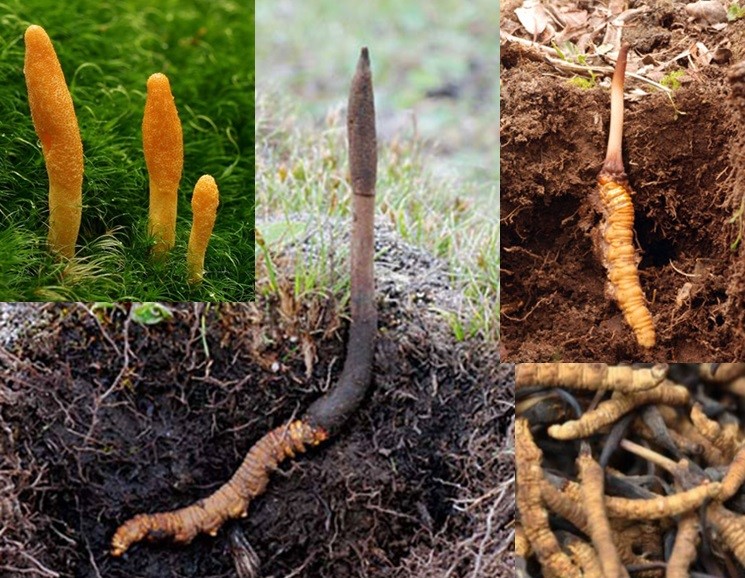
Information was collected through an open-ended questionnaire from a large number of individual respondents, as well as through semi-structured interviews. They were asked for herbs’ local names, traditional and commercial uses, parts used, and mode of administration. Information obtained in each locality was cross-checked at different places with other respondents. To substantiate the usefulness of CS, scientific information for the chemical constituents, curative effect, biological studies, and pharmacological studies was collated from journals.
CORDYCEPS SINENSIS
- Sinensisis an annual Ascomycetes fungus closely related to the mushroom. Although not actually a mushroom taxonomically, it has been described as an exotic medicinal mushroom in traditional Chinese and Tibetan medicine. The name cordycepscomes from Latin words meaning club and head. The mycological features, related species and vernacular names are given in Table 1. The normal harvesting period stretches from April to August. It grows only in high-altitude regions of about 3800 m above sea level, in cold, grassy, alpine meadows of the Himalayan mountains. The fungus is parasitic in nature. The base of the mushroom first originates from an insect larval host (Hepialis armoricanus family Hepialidac) and ends at the club-like cap, including the stipe and stroma. The fruit body is dark brown to black, and the root of organism, the larval body pervaded by the mycelium, is yellowish to brown color.[7] The immature larvae (host) on which cordyceps grows usually lies about 6 inches below the surface of the ground. As the fungus approaches maturity, it consumes more than 90% of the infected insect effectively mummifying its host. As the stroma matures, it swells up and develops perihelia. The average weight of cordyceps is about 300–500 mg.
Table 1
Mycological features and vernacular names of Cordyceps sinensis
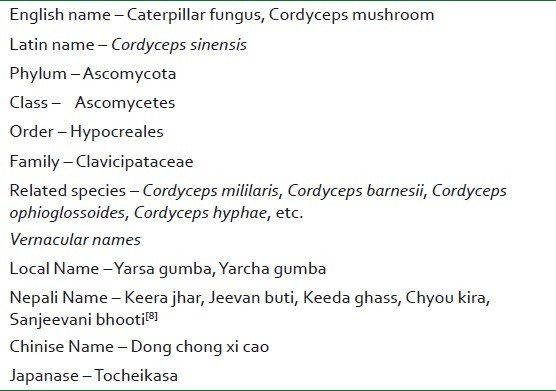
RESULT AND DISCUSSION
The people of North Sikkim call the fungus/mushroom/herb yarsa gumba; its Tibetan name [winter (yarsa) and summer (gumba)]. In the literature, “gunba” or “gonba” have also been used instead of “gumba.” It is called Keera Jhar (insect herb) by the local Nepalese. It is also known as the Himalayan Viagra. It costs approximately 6.77 U.S. dollar per piece in the international market and is locally available at Rs.100/- per piece.
Initially local herders observed that yak, goat, sheep, etc. consuming C. Sinensis during their grazing in the forest became very strong and stout. This observation paved the way for the discovery of its medicinal value. Thereafter, local people and herders used the fungus powder with jaggery to increase milk production, and improve reproductive capacity and vitality of their cattle. Then its relevant medicinal properties were explored, collecting only the aerial part (fruiting body/stroma), which they dried in sunlight as primary processing. Then they themselves consumed it and became convinced of its medicinal effects in enhancing vigor and vitality. They further claimed that it has aphrodisiac effects, and hence they used to give it as a gift to relatives and friends from Gangtok and adjoining areas.

At present, local folk practitioners use the product alone or in combination with other medicinal herbs to treat various diseases, administering different doses for different ailments according to their experience, based on an empirical trial-and-error method. People of both sexes usually take one piece of C. Sinensiswith a cup of milk to enhance their sexual potency and desire. The Bhutia community put one piece of C. Sinensis in a cup of local-made alcohol (chang), leave it for 1 hour, and drink it morning and evening as a tonic. Some use hot water instead of alcohol. Some folk healers use C. Sinensis for diabetes and other wasting diseases. It is used for cancer mixed with texus leaf and Ginseng root decoction. Similar reports are also available from Nepal.[9–11] An attempt was made to evaluate the strength of the folk claims by counting the number of users for particular illnesses. Prolonged, continuous use by local folk healers/traditional healers for the treatment of 21 ailments, including cancer, bronchial asthma, bronchitis, TB, diabetes, cough and cold, erectile dysfunction, BHP, jaundice, alcoholic hepatitis, etc., were noted [Table 2]. Most traditional healers and elderly people use it to increase longevity and cure erectile dysfunction.[12]
Table 2
Traditional uses of Cordyceps sinensis (Yercha gumpa) in North Sikkim

Evidence and studies
Various pharmacological and biological studies establishing the curative effect of corydeps involving various experimental models (in vitro and in vivo) and some clinical trials in volunteer athletes.[13,14] C. Sinensis exhibits very broad biological and pharmacological actions in hepatic, renal, and cardiovascular diseases. It has effects on immunological disorders including cancer. Pharmacological actions of cordyceps are primarily due to bioactive polysaccharides, modified nucleosides, and cyclosporine like metabolites.
Also, the fermentable strain of the mycelia causes normal fat mobilization and beta-oxidation, thereby maintaining blood glucose level during prolonged exercise in athletes.
A Chinese study conducted on mice, a double-blind, placebo-controlled trial, investigated whether oral administration of cordyceps results in enhanced endurance and resistance to fatigue. After 3 weeks of administration, the groups given CS-4 were able to swim significantly longer than the control groups. The results of the study were dose-dependent with results of one group on a higher dose showing a 30% increase in endurance and the second group showing a 73% increase in endurance. The study concluded that the cardiotonic action, inhibition of tracheal constrictions, and relaxation of contracted vascular smooth muscle (which CS-4 evokes) increase the ability and endurance of exercise. Another double-blind, placebo-controlled study was conducted to test the effects on physical performance in 1998 led by S. Morrissey of Beijing Medical University Sports Research Institute. They found that the group given the most of the product containing cordyceps experienced improved lactate clearance. Researchers concluded that lactate clearance improved due to improved lactate energy metabolism within the cell. Hence the authors concluded that using this CS formulation would enhance lactate clearance and allow athletes greater anaerobic physical performance[15] [Table 3].
Table 3
Major pharmacological functions of Cordyceps sinensis[16]

Scientific proof of the effects of the Cordyceps mushroom seem to be quite promising and coincide with folk practices of Sikkim and other parts of India, China, Nepal and Bhutan. The Cordyceps mushroom also has potent antioxidant properties.[17]
Natural product chemistry of Cordyceps
Many natural products have been identified from the fruiting bodies and cultured mycelium of cordyceps and related species. The major chemical constituent is cordycepic acid with other amino acids, vitamins and minerals [Table 4].
Table 4
Chemical constituents of natural cordyceps[18–21]

CONCLUSION
The folk healers of Sikkim use C. Sinensis to cure 21 ailments including cancer, asthma, TB, diabetics, cough and cold, erectile dysfunction in males and female BHP, hepatitis, etc. Many studies in vitro and in vivo support C. Sinensis having diverse biological activities and pharmacological potential [Table 3]. Its effects on renal and hepatic function and immunomodulatory-related antitumor activities are most promising and deserve further attention. Although the origin and preparation of cordyceps have not always been clearly addressed, most studies use water-soluble, polysaccharide-rich fractions or alcohol extracts.
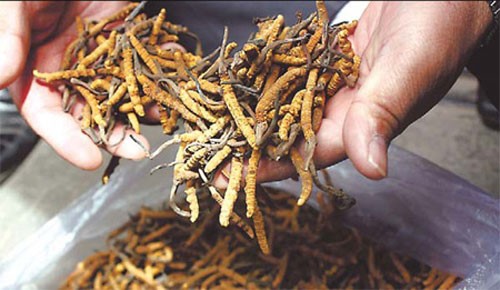
Now all possible measures have to be undertaken to ensure that a healthy environment is sustained so that substantial harvesting can be carried out for the medicinal fungi and plants, which will be able to provide the basic income for folk healers and other rural people. Fermented mycelia can be constantly produced on a large scale, and are a better source of the medicine. Available evidence regarding C. Sinensis's medicinal value look very promising, but there is a lack of study performed specifically on humans. More mechanism-based and disease-oriented pharmacological studies are required. The need of the hour is now to undertake detailed pharmacological studies of C. Sinensis for its pharmacokinetics, pharmacodynamics, and toxicities in humans. In the Ayurvedic pharmacopoeia, the mushroom/fungus, C. Sinensis, can be considered to fall in the Rasayana category.
REFERENCES
- Winkler D. Present and historic relevance of Yartsa Gunbu (Cordyceps sinensis).An ancient myco-medicinal in Tibet. Fungi. 2008;1:6–7.
- Wasson R. New York: New York Press; 1968. Gordon, Soma: Divine mushroom of immortality; pp. 3–4.
- Adhikari MK. Chyau: Ayurvediya vishleshan ek vivechana (Mushrooms: An Ayurvedic concepts) J Nep Pharm Asso. 1981;9:17–21.
- Howard JM. Potential of the fungus used in Chiense Traditional remedies: The catapillar fungus (Cordyceps sinensis) [Last accessed on 2003]. Available from: http://www.world-of-fungi.org/Mostly_Medical/James_Howard/James_HowardSSM.htm.
- Diggin FE. The true history of discovery of penicillin. Br J Biomed Sci. 1999;25:2–3.
- Hofmann A. Switzerland: J.B. Lippincott Company; 1970. The Discovery of LSD and Subsequent Investigations on Naturally Occurring Hallucinogens in Discoveries in Biological Psychiatry. Chapter -7; pp. 34–7.
- Kinjo N, Zang M. Morphological and phylogenetic studies on coryceps Sinensis. Mycoscience. 2001;42:567–74.
- Devkota S. Yarsagumba (Cordyceps sinensis): Reflection on Historical Perspectives. Soc Life. 2007;13:40–1.
- Devokota S. Yarsagumba [Cordyceps sinensis (Berk.) Sacc.] Traditional utilization in Dolpa district. West Nepal. Our Nat. 2006;4:48–52.
- Lama YC, Ghimire SK, Thomas YA. Amchis’ Knowledge and Conservation.Kathmandu: People and Plants Initiative, WWF Nepal Program; 2001. Medicinal Plants of Dolpo; p. 56.
- Adhikari MK, Devkota S, Tiwari RD. Ethnomycolgical Knowledge on Uses of Wild Mushrooms in Western and Central Nepal. Our Nat. 2005;3:13–9.
- Panda AK. Tracing the historical prospective of Cordyceps sinensis –an aphrodisiac in Sikkim Himalya. Ind J Hist Sci. 2010;45:189–98.
- Zhu JS, Halpen GM, Jones K. The scientific of an ancient Chinese medicine: Cordyceps sinensis. Part-1. J Altern Complement Med. 1998;4:289–303. [PubMed]
- Zhu JS, Halpen GM, Jones K. The Scientific study of an ancient Chinese medicine: Cordyceps sinensis. Part-2. J Altern Complement Med. 1998;4:429–57. [PubMed]
- Wang ZX, Wang XM, Wang TZ. Current status of pharmacological studies on Cordyceps sinensis and Cordyceps hyphae. Chung-Kuo Chung His I Chieh ho Tsa Chih. 1995;15:255–6. [PubMed]
- Wang SY, Shiao MS. Pharmacological function of Chinese medicinal fungus Cordyceps sinensis and related species. J Food Drug Anal. 2000;8:248–57.
- Li SP, Li P, Dong TT, Tsim KW. Anti –oxidant activity of different types of natural Cordyceps sinensis and cultured Cordyceps mycelia. Phytomedicine. 2001;8:207–12. [PubMed]
- Tsuno A, Taketomo N, Hiroyuki I. Healthful composition obtained from the hot water extract of Cordyceps sinensis mycelia. J Lab Clin Med. 1995;8:134–7.
- Xiao YQ, Liu JM, Tu YY. Studies on chemical constituents in Cordyceps sinensis. Bull Chin Mater Med. 1983;8:32–3.
- You-Ping Zhu. Australia: Harwood Academic Publication; 1998. Chinese Material Medical – Chimistry, Pharmacology and Appilcation; pp. 10–121.
- [Last accessed on 2010 Jul 05]. Available from: http://www. natural products.org(Manograph on cordyceps)
(Source: https://www.ncbi.nlm.nih.gov/pmc/articles/PMC3121254/)









